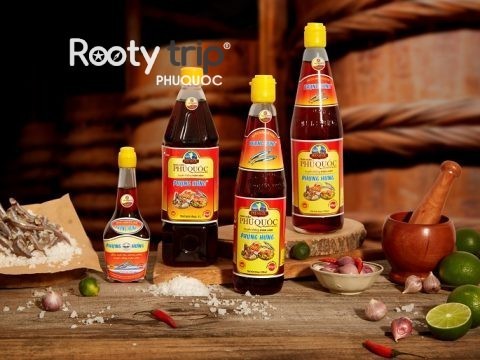Phu Quoc Pepper – Vietnam’s Best-Tasting Pepper
28/06/2025Phu Quoc pepper is one of the island’s most iconic specialties-well-known for its spicy heat, firm texture, and fragrant peel. For generations, the people of Phu Quoc have cultivated pepper not only as an economic crop but also as a source of cultural pride and tourism value.
Today, visiting local pepper farms has become a must-do for travelers looking for authentic, meaningful experiences. With Rooty Trip, you’ll get a chance to explore this flavorful tradition and find out why Phu Quoc pepper makes such a special gift. Let’s dive deeper into its story in the article below.
What Makes Phu Quoc Pepper Special?

Phu Quoc pepper isn’t just a local ingredient-it’s a symbol of tradition, quality, and the island’s unique connection to nature. Here’s why it stands out among the world’s finest peppers
Unique terroir & climate
Phu Quoc’s rich red soil, combined with its warm tropical climate and just the right amount of rainfall, creates the perfect conditions for growing high-quality pepper. The island’s natural environment gives the pepper a distinct aromatic heat and depth of flavor that’s hard to find elsewhere.
Hand-picked traditional farming
Unlike mass-produced pepper, Phu Quoc pepper is still harvested using traditional methods. Local farmers hand-pick each bunch, sun-dry them naturally, and carefully sort the best berries. This time-honored process preserves the pepper’s strong aroma and ensures the natural oils stay intact.
Comparison with Kampot & Tellicherry peppers
While Kampot pepper from Cambodia and Tellicherry pepper from India are also world-renowned, Phu Quoc pepper holds its own with its bold, spicy kick and slightly sweet aftertaste. It’s less citrusy than Kampot and more intense than Tellicherry-making it a favorite among Vietnamese chefs and international food lovers alike.
Varieties of Phu Quoc Pepper
Phu Quoc is home to several types of pepper, each with its own flavor profile and culinary use. From bold and spicy to smooth and aromatic, these varieties reflect the care and tradition behind every harvest.
Black Pepper – Bold & Versatile
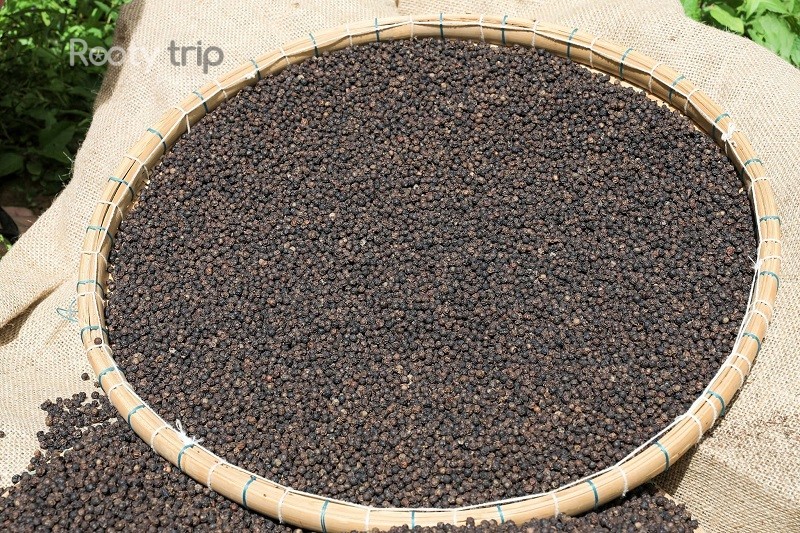
This is the most common and widely used variety. Phu Quoc black pepper is known for its strong aroma and sharp, lingering heat. It’s harvested when the berries are nearly ripe, then sun-dried until they turn dark. Perfect for everyday cooking-from marinades and stir-fries to grilled meats and noodle dishes.
White Pepper (or tiêu sọ) – Smooth & Subtle

Made by soaking fully ripe berries and removing their outer skin, white pepper has a milder, earthy flavor. It blends smoothly into creamy dishes, sauces, and soups without leaving black specks, making it ideal for Western-style sauces, seafood, and chicken-based recipes.
Red/Ripe Pepper (or tiêu chín) – Rare & Refined
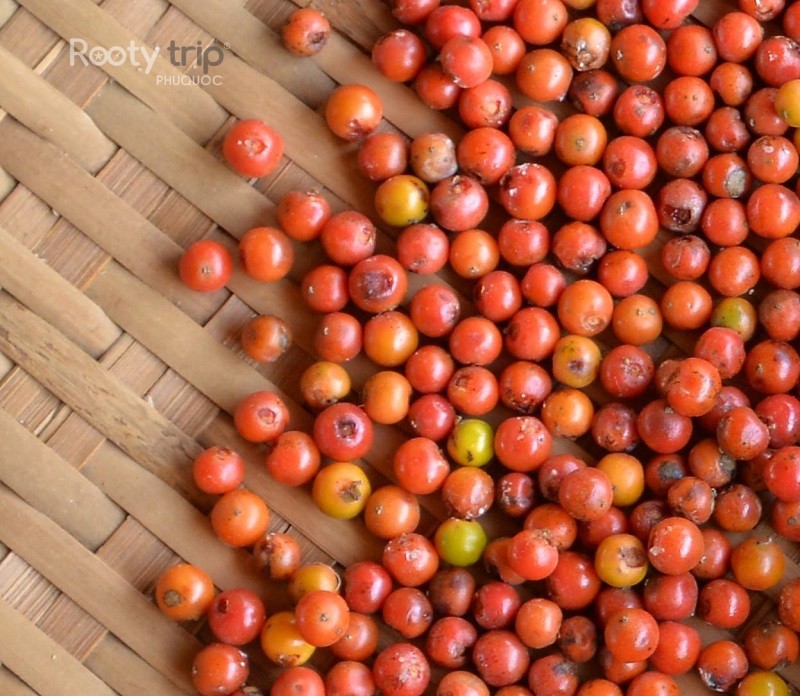
This variety is made from fully ripened pepper berries and is considered the most premium type. With a more fruity and complex flavor, red pepper is often used in gourmet dishes or sold as a specialty product. Because of its limited harvest and delicate process, it’s both rare and more expensive—but well worth a try.
Green Pepper – Freshness Unleashed
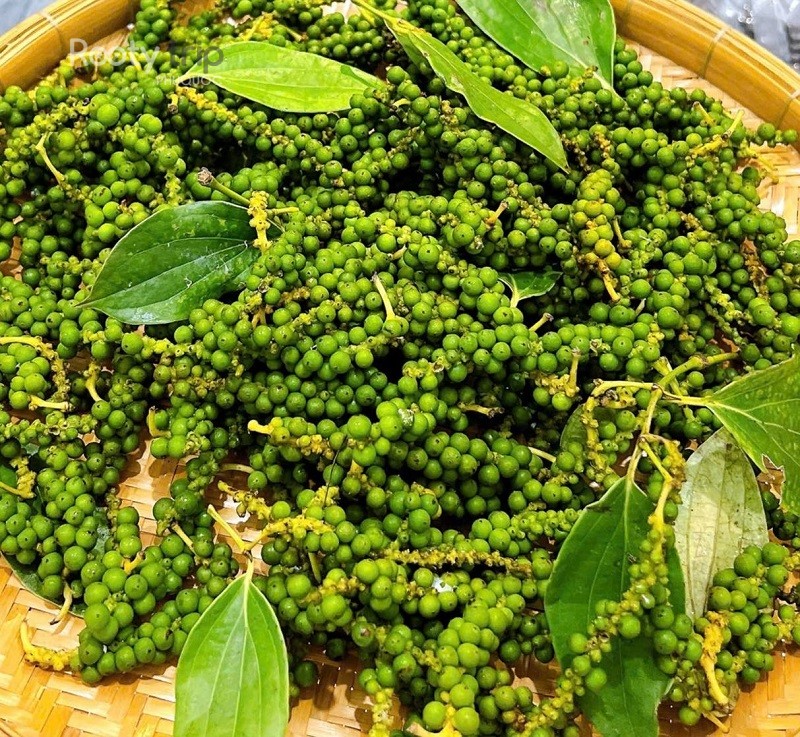
Green pepper is picked early and either brined or used fresh. It delivers a mild, bright heat with a hint of freshness that dried pepper doesn’t have. Commonly used in Phu Quoc’s famous green pepper crab dish, it’s also great in sauces and pickles for a subtle kick.
The Journey from Farm to Table: Cultivation and Processing
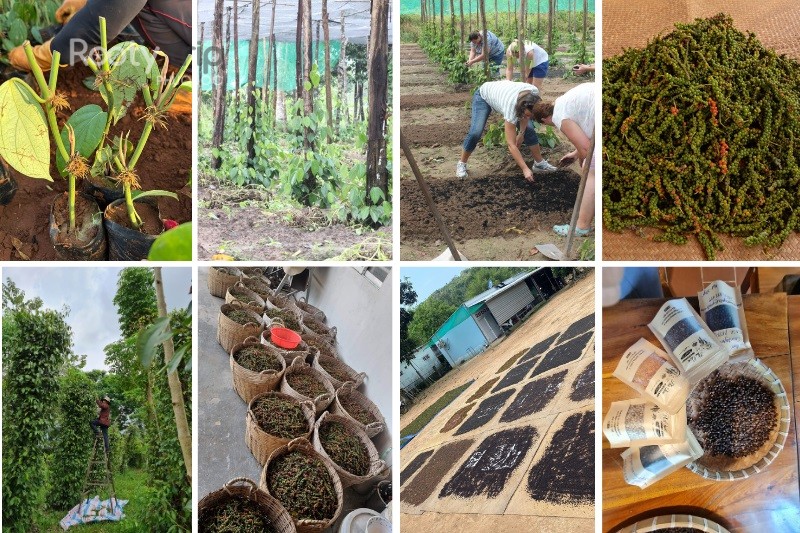
Behind every peppercorn from Phu Quoc is a story of patience, skill, and tradition. The journey from farm to table is a year-long process that reflects the deep-rooted connection between the island’s farmers and their land.
Planting and Care: A Year-Round Dedication
The process begins with selecting healthy seedlings, often grown from mature pepper vines. Farmers plant these seedlings at the base of support poles-usually wooden trunks or live trees-to help the vines climb as they grow.
Throughout the year, the plants require constant care. Regular watering, weeding, and fertilizing-often using organic compost-ensure that the vines stay healthy and productive. This hands-on approach, passed down through generations, is what gives Phu Quoc pepper its strong, natural flavor.
Harvesting Season: A Time of Abundance
Pepper is typically harvested once a year, from late January to April. This is when the berries reach the ideal stage of ripeness, depending on the type of pepper being produced.
Harvesting is done entirely by hand. Skilled farmers carefully pick each bunch to avoid damaging the vines. The timing is crucial-berries picked too early or too late can affect the aroma and spice level. For red or ripe pepper, only the fully matured berries are selected, making the process even more selective and labor-intensive.
Drying and Processing: Crafting the Spice
After harvesting, the peppercorns are cleaned and laid out to dry under the sun for several days. This traditional sun-drying method helps preserve the natural oils in the pepper and intensifies its aroma.
Different drying and processing techniques lead to different pepper types. For example, black pepper is dried with the outer skin intact, while white pepper involves soaking and removing the skin. Red pepper is sun-dried at peak ripeness to retain its distinctive flavor, and green pepper is often preserved in brine or used fresh.
Each step, from vine to final product, is handled with care to maintain the quality that Phu Quoc pepper is known for-not just in Vietnam, but increasingly around the world.
Visiting a Phu Quoc Pepper Farm: An Immersive Experience
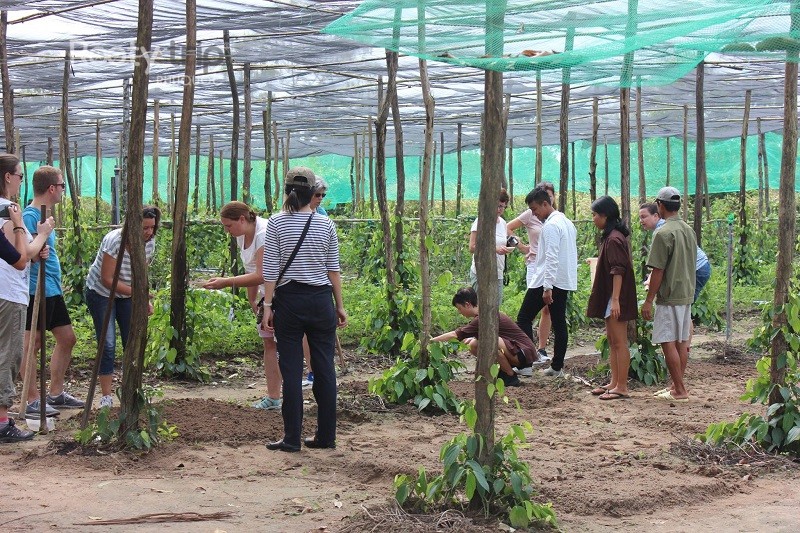
Join us as we explore what it’s like to walk through a pepper farm in Phu Quoc, learn how the famous spice is grown, and connect with the local culture in the most flavorful way below:
Top Pepper Farms to Explore
Some of the most popular farms for visitors include Khu Tuong and Suoi Da, located in the northern part of Phu Quoc. These family-owned farms welcome guests who are eager to learn how Phu Quoc pepper is grown-from planting and daily care to harvesting and drying.
Visitors can:
- Walk through lush, green pepper gardens
- Learn traditional farming techniques passed down through generations
- Discover how careful drying methods affect flavor
- Watch seasonal hand-picking (January-April)
- Buy authentic Phu Quoc pepper directly at the farm shop
Many farms also offer guided tastings, where you can compare different varieties and understand how Phu Quoc pepper vs. other peppers (like Kampot or Tellicherry) differ in taste, aroma, and intensity.
Tips for Visiting:
- Best time: November to April, especially during harvest season
- What to wear: Light, breathable clothes and sun protection
- Book through local agencies like Rooty Trip for extra convenience and local insights
The Experience: Scent, Sight, and Taste
The moment you step into a pepper farm, you’ll be surrounded by a natural aroma-warm, earthy, and slightly spicy. Rows of vines stretch across the land, creating a peaceful, almost meditative atmosphere.
As you walk between the vines, you’ll see pepper berries at different stages of ripeness-green, red, and darkening black. Farmers may even let you touch or smell the fresh berries to truly appreciate their quality. This hands-on approach gives a real sense of how Phu Quoc pepper is grown, with love, care, and attention to detail.
At the end of most tours, you’ll have the chance to sample freshly ground pepper-far more fragrant and flavorful than anything mass-produced. Don’t miss the opportunity to buy authentic Phu Quoc pepper on the spot-ideal as gifts or for upgrading your home kitchen.
And if you’re wondering how it stacks up globally, tasting it side-by-side with other varieties will help you see the difference. Phu Quoc pepper vs. other peppers like Kampot or Tellicherry? Each has its charm, but Phu Quoc wins hearts with its bold heat and slightly sweet finish.
Phu Quoc pepper is just one of the island’s famous specialties. If you’re interested in more local flavors, don’t miss out on trying Sim wine Phu Quoc — a sweet and fragrant wine made from native rose myrtle fruit.
How to Choose and Buy Authentic Phu Quoc Pepper
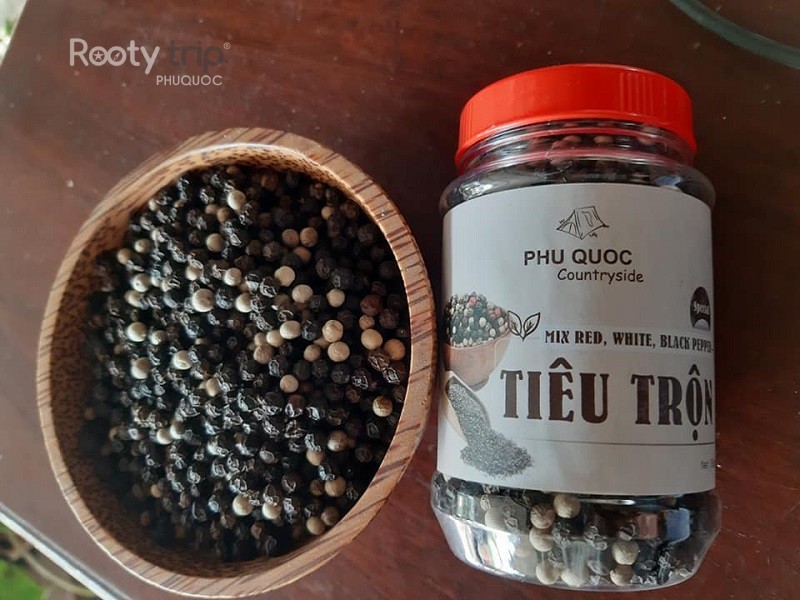
With so many pepper products on the market, it can be hard to tell which ones are truly local and high-quality. So, how can you be sure you’re getting the real thing? Let’s explore some practical tips and trusted sources together below.
Identifying Quality: Aroma, Appearance, and Origin
To recognize authentic Phu Quoc pepper, there are a few key characteristics to look for:
- Aroma: Real Phu Quoc pepper has a strong, sharp scent with a slightly sweet undertone. It shouldn’t smell dusty or dull.
- Appearance: The peppercorns are firm, dense, and evenly dried. Black pepper should have a dark, slightly wrinkled skin, while white and red types should look clean and glossy.
- Origin: Always check labels or ask the seller about the source. Authentic products should clearly state that they are grown and processed on Phu Quoc Island.
It’s best to buy from reputable farms or certified local shops, rather than mass-produced or generic pepper with unclear origins.
Where to Buy: Farms, Markets, and Specialty Shops
For the most authentic experience, purchase directly from trusted pepper farms such as:
- Đức Thạnh, Ngọc Hà, Huỳnh Thy, Phu Quoc Countryside or Đức Ninh – All of which offer on-site tours and sales
- Duong Dong Market – The island’s main local market, where many pepper sellers bring their freshest stock
- Specialty shops around Grand World or VinWonders that feature locally-sourced pepper products with clear branding and packaging
Buying directly from these sources not only ensures quality but also supports local farmers and keeps traditional farming alive.
Storing Phu Quoc Pepper for Longevity
Once you’ve brought your pepper home, store it correctly to keep its flavor and aroma intact:
- Keep it in an airtight container away from moisture and light
- Avoid plastic bags or loose jars, which can allow air and humidity to degrade the spice
- For long-term use, store whole peppercorns and only grind them when needed to preserve freshness
Proper storage can help your pepper last for up to 12-18 months without losing its signature taste.
Phu Quoc Pepper in Cuisine: Beyond a Simple Seasoning
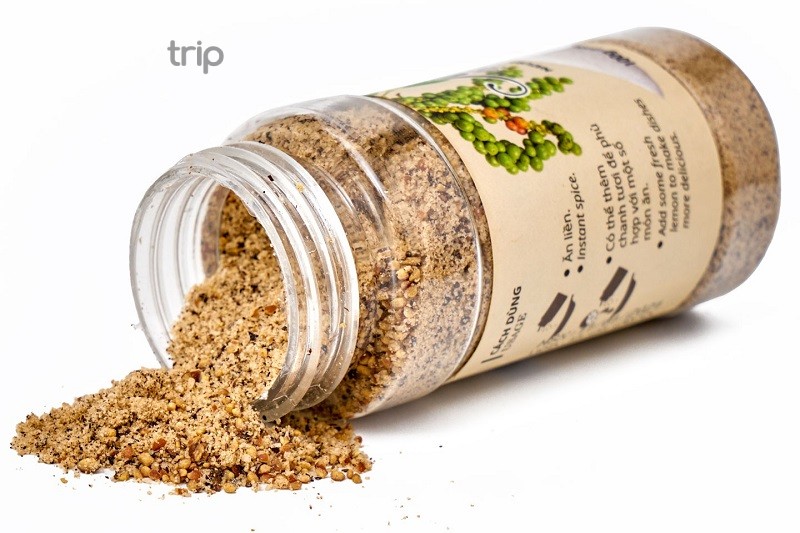
Phu Quoc pepper is more than just a spice-it’s an essential part of the island’s rich culinary heritage. With its bold aroma and layered flavor, this local ingredient brings depth and character to everything from traditional dishes to modern recipes. Let’s explore some of the best ways to use Phu Quoc pepper in cooking below.
Pairing with Local Dishes
Pepper is a cornerstone of many traditional Phu Quoc recipes, especially when combined with the island’s other signature ingredient-Phu Quoc fish sauce. Here are a few beloved dishes where pepper takes center stage:
- Cua rang tiêu xanh (Stir-fried crab with green pepper): A local favorite where fresh crab is cooked with whole green peppercorns, creating a fragrant, peppery glaze.
- Gà hấp tiêu (Pepper-steamed chicken): A simple yet flavorful dish that uses crushed black pepper to elevate the taste of tender chicken.
- Cá kho tiêu (Braised fish with pepper): Typically made with local mackerel or catfish, this dish features rich, savory sauce infused with freshly ground pepper.
- Muối tiêu chấm hải sản (Seafood dipping salt with pepper): This blend of salt, freshly ground black pepper, and a squeeze of local lime creates the perfect dipping sauce for steamed or grilled seafood. The sharp tang of the lime balances the saltiness and highlights the natural sweetness of shrimp, squid, and shellfish caught fresh from the island’s waters.
In these dishes, Phu Quoc pepper isn’t just for heat-it adds complexity and aroma, enhancing the essence of the ingredients without overpowering them.
Creative Uses in Modern Cooking
Phu Quoc pepper also shines beyond traditional Vietnamese food. Its distinct flavor profile makes it a great addition to everyday home cooking and gourmet experiments alike. Here are a few ideas:
- Add freshly ground black or red pepper to roasted vegetables, grilled meats, or creamy soups for a vibrant twist
- Mix into homemade marinades or dressings-especially those with citrus or honey-for a balance of sweet and spice
- Use white pepper in cream-based dishes like mashed potatoes or pasta sauces for a smoother finish
- Sprinkle over avocado toast, eggs, or stir-fried greens for a simple upgrade
- Try it in desserts-yes, really! A pinch of red or black pepper adds a subtle warmth to chocolate truffles or fruit compote
Whether used in everyday meals or special creations, Phu Quoc pepper adds a story to every bite-a reminder of the island’s soil, sun, and tradition.
Buying & Shipping Internationally
For travelers or international customers who fall in love with the bold flavor of Phu Quoc pepper, the good news is: you can take the taste home with you. Whether you’re buying it during your trip or ordering online, here’s what you need to know to ensure a smooth and successful delivery.
Packaging for Export
Phu Quoc pepper is often vacuum-sealed or packed in airtight glass jars to preserve its natural aroma and prevent moisture during transport. Many local farms and producers now offer pepper that meets international packaging standards, including proper labeling (origin, ingredients, expiration date), and hygienic processing. This ensures freshness and compliance with import/export requirements.
If you’re purchasing pepper to bring home in your luggage, make sure it’s well-sealed and stored in your checked baggage, especially for larger quantities.
Customs & Import Rules
Each country has its own customs regulations when it comes to importing food products, even dried spices. Most countries allow small amounts of pepper for personal use, but for larger orders or commercial shipments:
- Check local import laws related to dried agricultural products
- Be sure the product includes clear labeling and certificate of origin, if required
- Avoid mixed spice blends unless they’re commercially packaged and approved
- Some countries may require phytosanitary certificates for bulk orders
When in doubt, it’s best to consult your local customs office before placing an international order.
Trusted Online Sellers
To ensure authenticity and quality, buy from reputable suppliers who specialize in Vietnamese products or work directly with local farms in Phu Quoc. Here are a few options to consider:
- Official websites of farms like Đức Thạnh, Ngọc Hà, Huỳnh Thy, or Phu Quoc Countryside
- Vietnamese specialty stores on platforms like Shopee, Lazada, Tiki (for local delivery)
- International platforms (e.g., Etsy or Amazon) featuring verified sellers of Vietnamese spices
- Rooty Trip or local travel agencies that offer delivery or shipping support for tourists post-trip
Always check for customer reviews, clear photos, and return policies when ordering online.
Phu Quoc pepper is more than just a spice-it’s a symbol of local identity, hard work, and island heritage. Grown under the bright sun and coastal winds, it not only supports the livelihoods of local farmers but also plays a vital role in cultural tourism. Visiting pepper farms has become a unique and meaningful experience for travelers, offering a closer look at traditional farming life. Whether as a flavorful souvenir or a story-rich ingredient, Phu Quoc pepper is a gift worth bringing home. Let Rooty Trip guide you to explore the authentic charm of Phu Quoc’s pepper villages and discover the rich flavors behind every grain.
Whether you’re a foodie, a home cook, or an adventurous traveler looking to combine culture with nature, be sure to add both a pepper farm visit and a Phu Quoc snorkeling trip to your itinerary.





